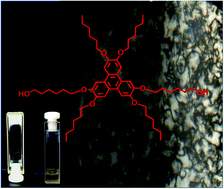Supramolecular organogels based on mesogenic 2,7-difunctionalized triphenylenes as a simple system for water content assessment in light alcohols†
Abstract
A series of three triphenylene compounds – denoted 2,7-THTP-DiCnOH – bearing four hexyloxy ancillary chains and two variable-length alkoxy chains terminally functionalized with hydroxyl groups have been synthesized and characterized. The studied compounds exhibited thermotropic mesomorphism; the detailed nature of the mesophases was found to depend on the relative positions of the terminal functional groups relative to the crown formed by the ancillary chains. All the studied compounds were able to act as supramolecular gelators in a variety of alcohols; their organogelating ability has been rationalized in terms of physicochemical parameters like the dielectric constant, which allowed us to establish very precise predictive “solvent gelation windows” for each compound. Remarkably stable gels have been detected for 2,7-THTP-DiC6OH in methanol. As a proof of principle, we present the water sensing performance as a rapid method for the assessment of water content in alcohol samples based on the influence that the water content exerts on the gels’ thermostability.



 Please wait while we load your content...
Please wait while we load your content...